Employment Law and Company Formation in UK
VerifiedAdded on 2023/06/08
|9
|2015
|90
AI Summary
This essay discusses the historical structure of employment law in UK since 1970s and whom it favours. It also presents the fundamental features of company formation in UK.
Contribute Materials
Your contribution can guide someone’s learning journey. Share your
documents today.
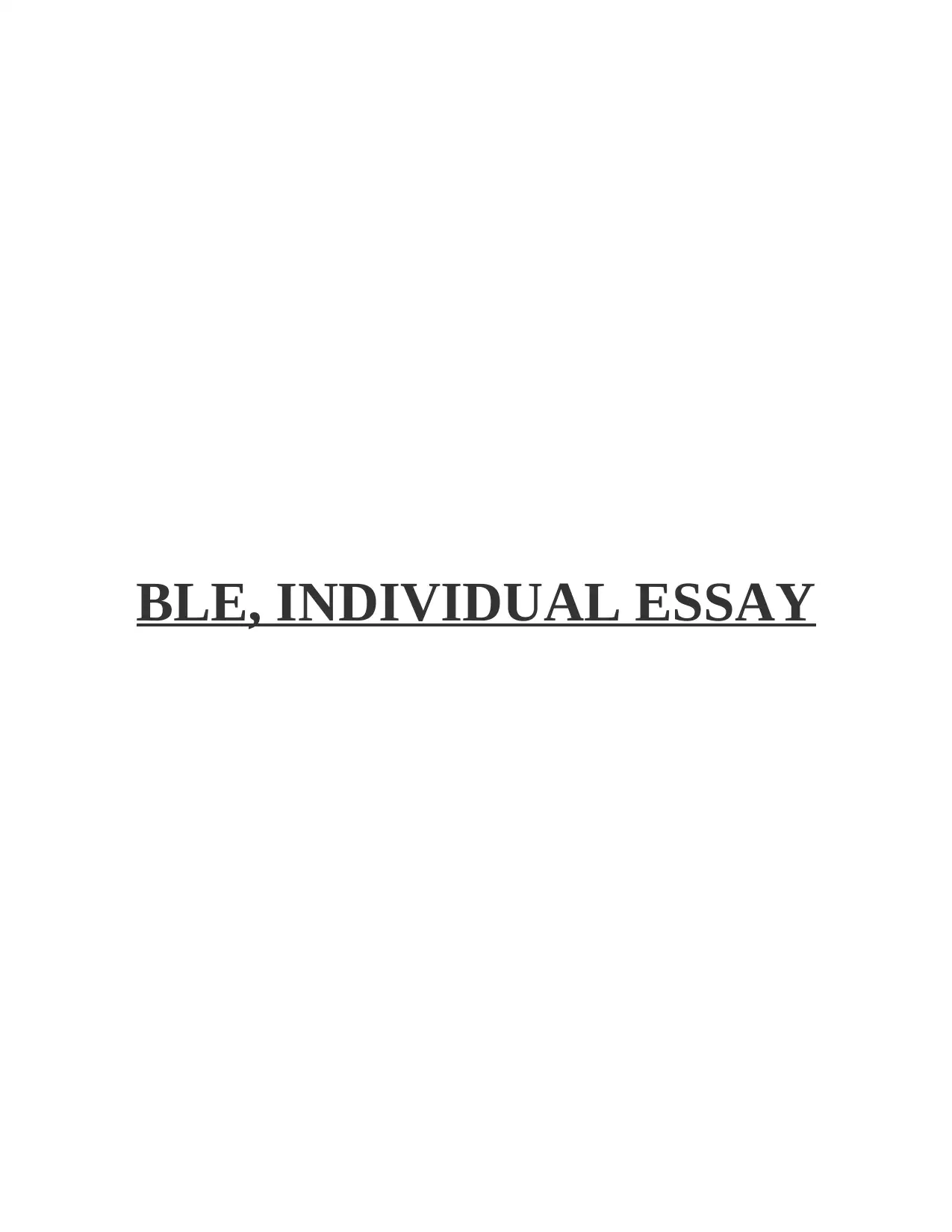
BLE, INDIVIDUAL ESSAY
Secure Best Marks with AI Grader
Need help grading? Try our AI Grader for instant feedback on your assignments.
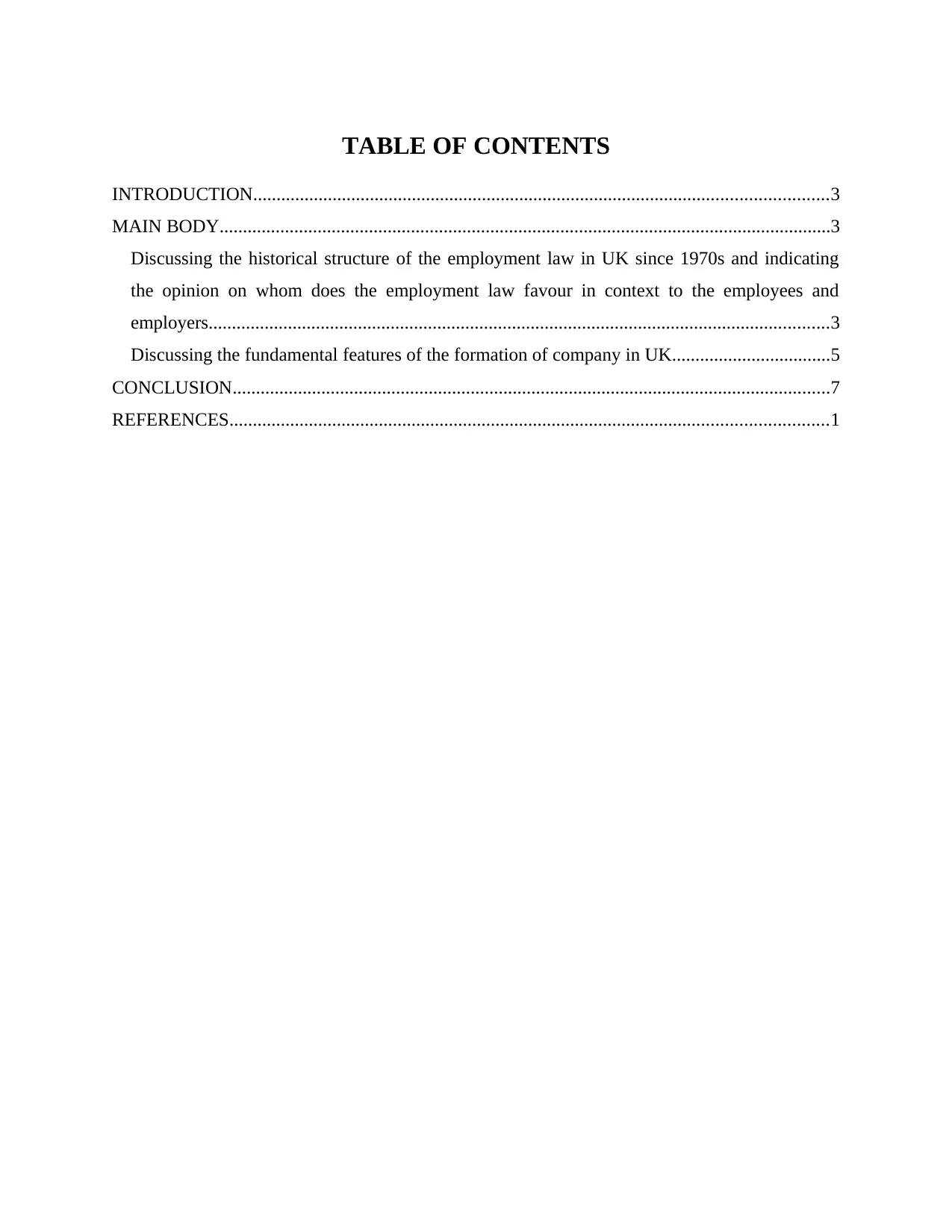
TABLE OF CONTENTS
INTRODUCTION...........................................................................................................................3
MAIN BODY...................................................................................................................................3
Discussing the historical structure of the employment law in UK since 1970s and indicating
the opinion on whom does the employment law favour in context to the employees and
employers.....................................................................................................................................3
Discussing the fundamental features of the formation of company in UK..................................5
CONCLUSION................................................................................................................................7
REFERENCES................................................................................................................................1
INTRODUCTION...........................................................................................................................3
MAIN BODY...................................................................................................................................3
Discussing the historical structure of the employment law in UK since 1970s and indicating
the opinion on whom does the employment law favour in context to the employees and
employers.....................................................................................................................................3
Discussing the fundamental features of the formation of company in UK..................................5
CONCLUSION................................................................................................................................7
REFERENCES................................................................................................................................1
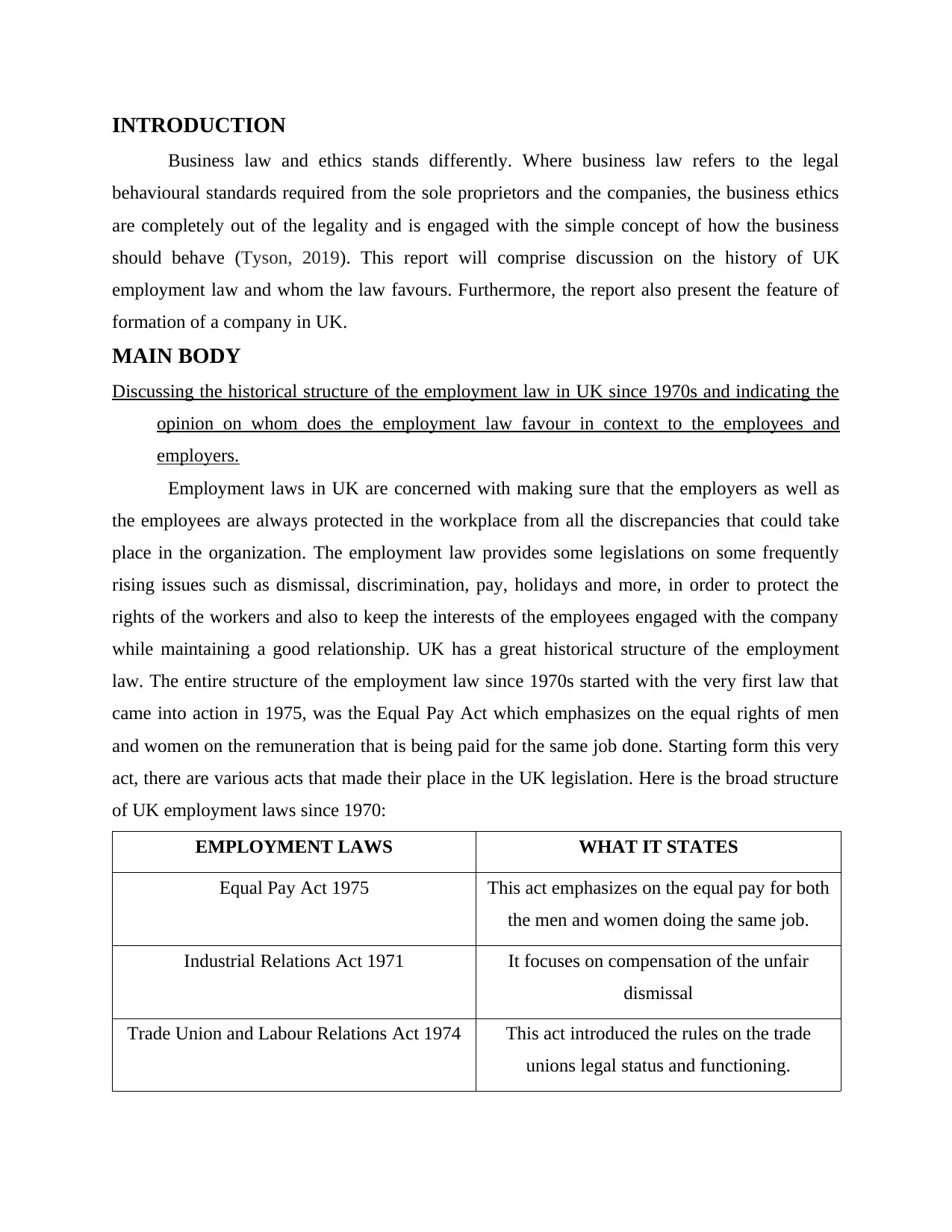
INTRODUCTION
Business law and ethics stands differently. Where business law refers to the legal
behavioural standards required from the sole proprietors and the companies, the business ethics
are completely out of the legality and is engaged with the simple concept of how the business
should behave (Tyson, 2019). This report will comprise discussion on the history of UK
employment law and whom the law favours. Furthermore, the report also present the feature of
formation of a company in UK.
MAIN BODY
Discussing the historical structure of the employment law in UK since 1970s and indicating the
opinion on whom does the employment law favour in context to the employees and
employers.
Employment laws in UK are concerned with making sure that the employers as well as
the employees are always protected in the workplace from all the discrepancies that could take
place in the organization. The employment law provides some legislations on some frequently
rising issues such as dismissal, discrimination, pay, holidays and more, in order to protect the
rights of the workers and also to keep the interests of the employees engaged with the company
while maintaining a good relationship. UK has a great historical structure of the employment
law. The entire structure of the employment law since 1970s started with the very first law that
came into action in 1975, was the Equal Pay Act which emphasizes on the equal rights of men
and women on the remuneration that is being paid for the same job done. Starting form this very
act, there are various acts that made their place in the UK legislation. Here is the broad structure
of UK employment laws since 1970:
EMPLOYMENT LAWS WHAT IT STATES
Equal Pay Act 1975 This act emphasizes on the equal pay for both
the men and women doing the same job.
Industrial Relations Act 1971 It focuses on compensation of the unfair
dismissal
Trade Union and Labour Relations Act 1974 This act introduced the rules on the trade
unions legal status and functioning.
Business law and ethics stands differently. Where business law refers to the legal
behavioural standards required from the sole proprietors and the companies, the business ethics
are completely out of the legality and is engaged with the simple concept of how the business
should behave (Tyson, 2019). This report will comprise discussion on the history of UK
employment law and whom the law favours. Furthermore, the report also present the feature of
formation of a company in UK.
MAIN BODY
Discussing the historical structure of the employment law in UK since 1970s and indicating the
opinion on whom does the employment law favour in context to the employees and
employers.
Employment laws in UK are concerned with making sure that the employers as well as
the employees are always protected in the workplace from all the discrepancies that could take
place in the organization. The employment law provides some legislations on some frequently
rising issues such as dismissal, discrimination, pay, holidays and more, in order to protect the
rights of the workers and also to keep the interests of the employees engaged with the company
while maintaining a good relationship. UK has a great historical structure of the employment
law. The entire structure of the employment law since 1970s started with the very first law that
came into action in 1975, was the Equal Pay Act which emphasizes on the equal rights of men
and women on the remuneration that is being paid for the same job done. Starting form this very
act, there are various acts that made their place in the UK legislation. Here is the broad structure
of UK employment laws since 1970:
EMPLOYMENT LAWS WHAT IT STATES
Equal Pay Act 1975 This act emphasizes on the equal pay for both
the men and women doing the same job.
Industrial Relations Act 1971 It focuses on compensation of the unfair
dismissal
Trade Union and Labour Relations Act 1974 This act introduced the rules on the trade
unions legal status and functioning.
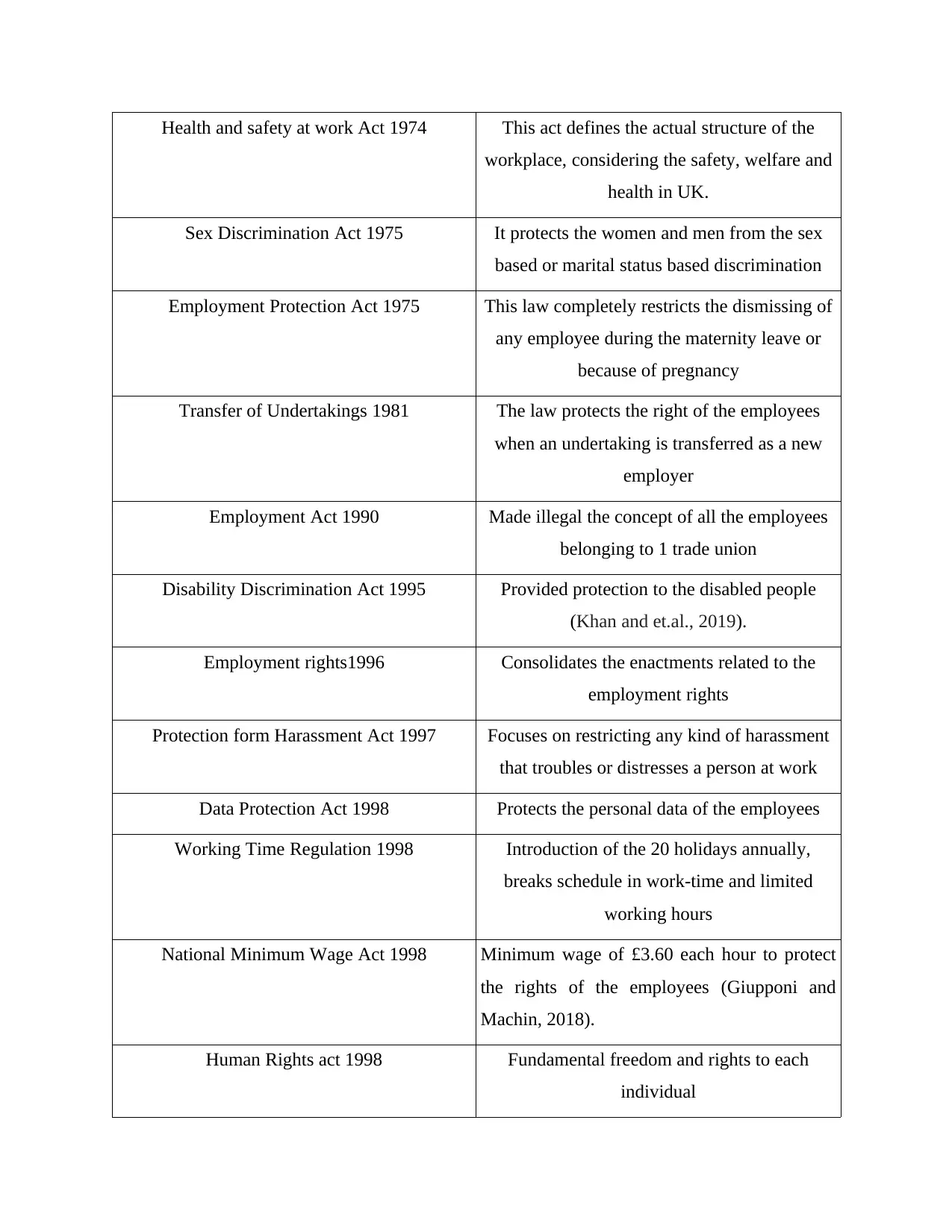
Health and safety at work Act 1974 This act defines the actual structure of the
workplace, considering the safety, welfare and
health in UK.
Sex Discrimination Act 1975 It protects the women and men from the sex
based or marital status based discrimination
Employment Protection Act 1975 This law completely restricts the dismissing of
any employee during the maternity leave or
because of pregnancy
Transfer of Undertakings 1981 The law protects the right of the employees
when an undertaking is transferred as a new
employer
Employment Act 1990 Made illegal the concept of all the employees
belonging to 1 trade union
Disability Discrimination Act 1995 Provided protection to the disabled people
(Khan and et.al., 2019).
Employment rights1996 Consolidates the enactments related to the
employment rights
Protection form Harassment Act 1997 Focuses on restricting any kind of harassment
that troubles or distresses a person at work
Data Protection Act 1998 Protects the personal data of the employees
Working Time Regulation 1998 Introduction of the 20 holidays annually,
breaks schedule in work-time and limited
working hours
National Minimum Wage Act 1998 Minimum wage of £3.60 each hour to protect
the rights of the employees (Giupponi and
Machin, 2018).
Human Rights act 1998 Fundamental freedom and rights to each
individual
workplace, considering the safety, welfare and
health in UK.
Sex Discrimination Act 1975 It protects the women and men from the sex
based or marital status based discrimination
Employment Protection Act 1975 This law completely restricts the dismissing of
any employee during the maternity leave or
because of pregnancy
Transfer of Undertakings 1981 The law protects the right of the employees
when an undertaking is transferred as a new
employer
Employment Act 1990 Made illegal the concept of all the employees
belonging to 1 trade union
Disability Discrimination Act 1995 Provided protection to the disabled people
(Khan and et.al., 2019).
Employment rights1996 Consolidates the enactments related to the
employment rights
Protection form Harassment Act 1997 Focuses on restricting any kind of harassment
that troubles or distresses a person at work
Data Protection Act 1998 Protects the personal data of the employees
Working Time Regulation 1998 Introduction of the 20 holidays annually,
breaks schedule in work-time and limited
working hours
National Minimum Wage Act 1998 Minimum wage of £3.60 each hour to protect
the rights of the employees (Giupponi and
Machin, 2018).
Human Rights act 1998 Fundamental freedom and rights to each
individual
Secure Best Marks with AI Grader
Need help grading? Try our AI Grader for instant feedback on your assignments.
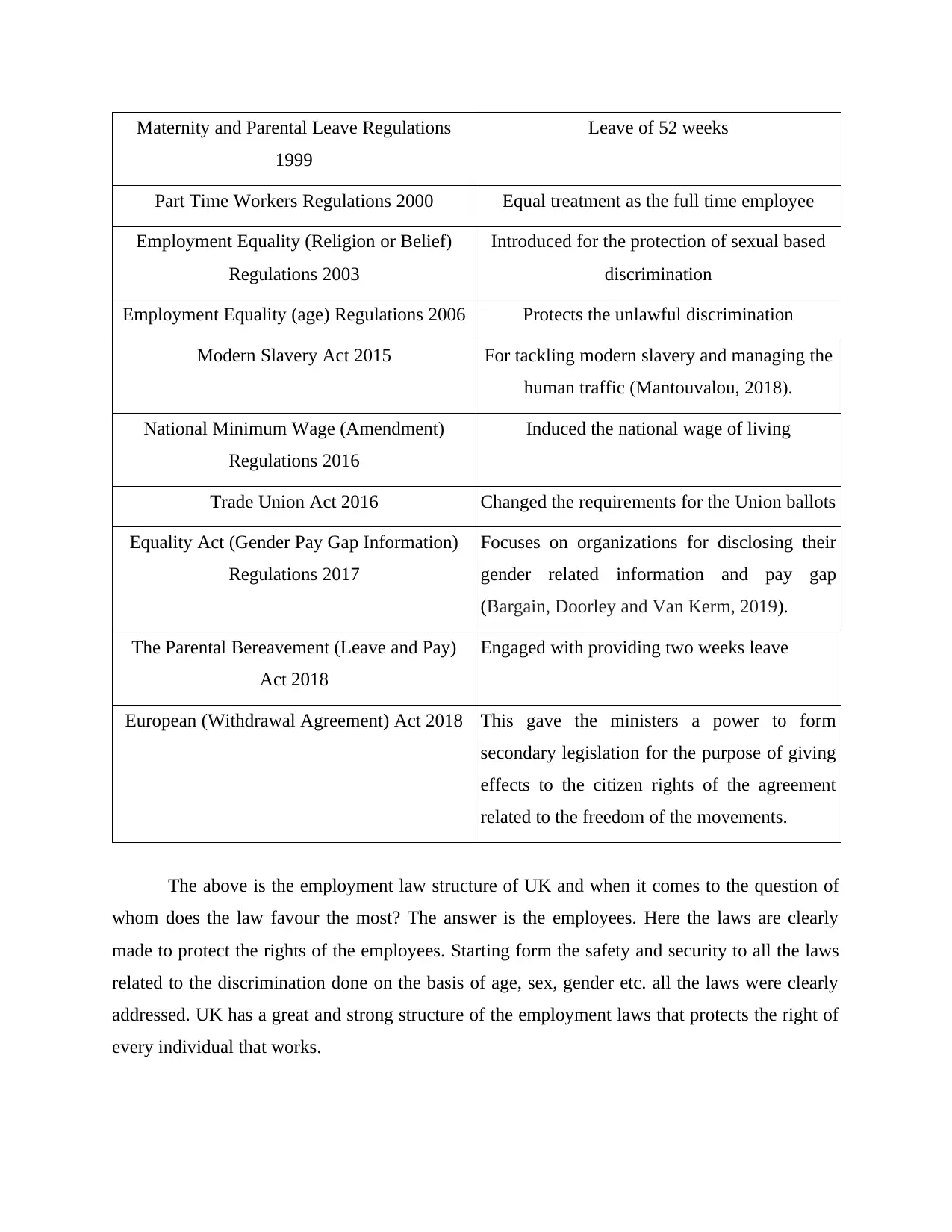
Maternity and Parental Leave Regulations
1999
Leave of 52 weeks
Part Time Workers Regulations 2000 Equal treatment as the full time employee
Employment Equality (Religion or Belief)
Regulations 2003
Introduced for the protection of sexual based
discrimination
Employment Equality (age) Regulations 2006 Protects the unlawful discrimination
Modern Slavery Act 2015 For tackling modern slavery and managing the
human traffic (Mantouvalou, 2018).
National Minimum Wage (Amendment)
Regulations 2016
Induced the national wage of living
Trade Union Act 2016 Changed the requirements for the Union ballots
Equality Act (Gender Pay Gap Information)
Regulations 2017
Focuses on organizations for disclosing their
gender related information and pay gap
(Bargain, Doorley and Van Kerm, 2019).
The Parental Bereavement (Leave and Pay)
Act 2018
Engaged with providing two weeks leave
European (Withdrawal Agreement) Act 2018 This gave the ministers a power to form
secondary legislation for the purpose of giving
effects to the citizen rights of the agreement
related to the freedom of the movements.
The above is the employment law structure of UK and when it comes to the question of
whom does the law favour the most? The answer is the employees. Here the laws are clearly
made to protect the rights of the employees. Starting form the safety and security to all the laws
related to the discrimination done on the basis of age, sex, gender etc. all the laws were clearly
addressed. UK has a great and strong structure of the employment laws that protects the right of
every individual that works.
1999
Leave of 52 weeks
Part Time Workers Regulations 2000 Equal treatment as the full time employee
Employment Equality (Religion or Belief)
Regulations 2003
Introduced for the protection of sexual based
discrimination
Employment Equality (age) Regulations 2006 Protects the unlawful discrimination
Modern Slavery Act 2015 For tackling modern slavery and managing the
human traffic (Mantouvalou, 2018).
National Minimum Wage (Amendment)
Regulations 2016
Induced the national wage of living
Trade Union Act 2016 Changed the requirements for the Union ballots
Equality Act (Gender Pay Gap Information)
Regulations 2017
Focuses on organizations for disclosing their
gender related information and pay gap
(Bargain, Doorley and Van Kerm, 2019).
The Parental Bereavement (Leave and Pay)
Act 2018
Engaged with providing two weeks leave
European (Withdrawal Agreement) Act 2018 This gave the ministers a power to form
secondary legislation for the purpose of giving
effects to the citizen rights of the agreement
related to the freedom of the movements.
The above is the employment law structure of UK and when it comes to the question of
whom does the law favour the most? The answer is the employees. Here the laws are clearly
made to protect the rights of the employees. Starting form the safety and security to all the laws
related to the discrimination done on the basis of age, sex, gender etc. all the laws were clearly
addressed. UK has a great and strong structure of the employment laws that protects the right of
every individual that works.
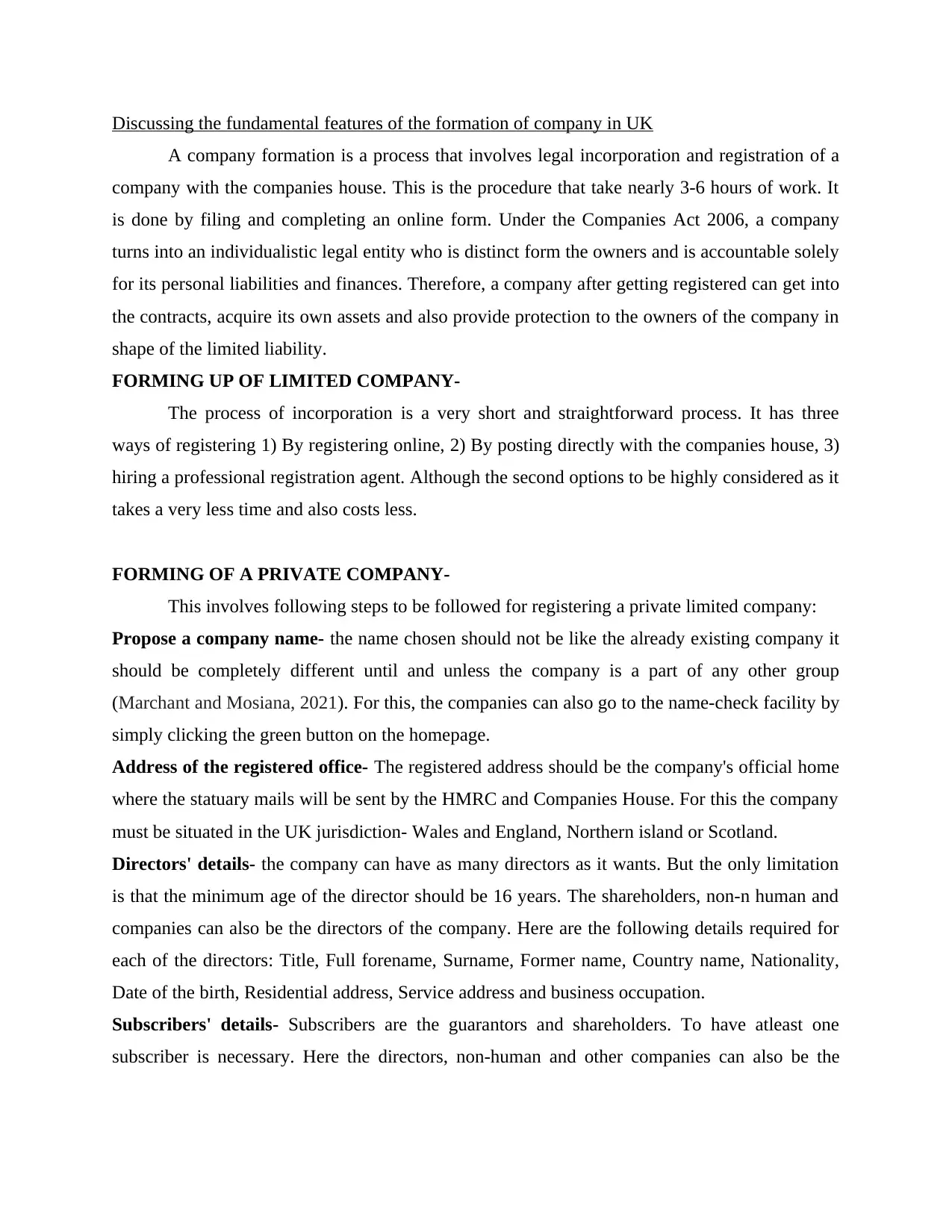
Discussing the fundamental features of the formation of company in UK
A company formation is a process that involves legal incorporation and registration of a
company with the companies house. This is the procedure that take nearly 3-6 hours of work. It
is done by filing and completing an online form. Under the Companies Act 2006, a company
turns into an individualistic legal entity who is distinct form the owners and is accountable solely
for its personal liabilities and finances. Therefore, a company after getting registered can get into
the contracts, acquire its own assets and also provide protection to the owners of the company in
shape of the limited liability.
FORMING UP OF LIMITED COMPANY-
The process of incorporation is a very short and straightforward process. It has three
ways of registering 1) By registering online, 2) By posting directly with the companies house, 3)
hiring a professional registration agent. Although the second options to be highly considered as it
takes a very less time and also costs less.
FORMING OF A PRIVATE COMPANY-
This involves following steps to be followed for registering a private limited company:
Propose a company name- the name chosen should not be like the already existing company it
should be completely different until and unless the company is a part of any other group
(Marchant and Mosiana, 2021). For this, the companies can also go to the name-check facility by
simply clicking the green button on the homepage.
Address of the registered office- The registered address should be the company's official home
where the statuary mails will be sent by the HMRC and Companies House. For this the company
must be situated in the UK jurisdiction- Wales and England, Northern island or Scotland.
Directors' details- the company can have as many directors as it wants. But the only limitation
is that the minimum age of the director should be 16 years. The shareholders, non-n human and
companies can also be the directors of the company. Here are the following details required for
each of the directors: Title, Full forename, Surname, Former name, Country name, Nationality,
Date of the birth, Residential address, Service address and business occupation.
Subscribers' details- Subscribers are the guarantors and shareholders. To have atleast one
subscriber is necessary. Here the directors, non-human and other companies can also be the
A company formation is a process that involves legal incorporation and registration of a
company with the companies house. This is the procedure that take nearly 3-6 hours of work. It
is done by filing and completing an online form. Under the Companies Act 2006, a company
turns into an individualistic legal entity who is distinct form the owners and is accountable solely
for its personal liabilities and finances. Therefore, a company after getting registered can get into
the contracts, acquire its own assets and also provide protection to the owners of the company in
shape of the limited liability.
FORMING UP OF LIMITED COMPANY-
The process of incorporation is a very short and straightforward process. It has three
ways of registering 1) By registering online, 2) By posting directly with the companies house, 3)
hiring a professional registration agent. Although the second options to be highly considered as it
takes a very less time and also costs less.
FORMING OF A PRIVATE COMPANY-
This involves following steps to be followed for registering a private limited company:
Propose a company name- the name chosen should not be like the already existing company it
should be completely different until and unless the company is a part of any other group
(Marchant and Mosiana, 2021). For this, the companies can also go to the name-check facility by
simply clicking the green button on the homepage.
Address of the registered office- The registered address should be the company's official home
where the statuary mails will be sent by the HMRC and Companies House. For this the company
must be situated in the UK jurisdiction- Wales and England, Northern island or Scotland.
Directors' details- the company can have as many directors as it wants. But the only limitation
is that the minimum age of the director should be 16 years. The shareholders, non-n human and
companies can also be the directors of the company. Here are the following details required for
each of the directors: Title, Full forename, Surname, Former name, Country name, Nationality,
Date of the birth, Residential address, Service address and business occupation.
Subscribers' details- Subscribers are the guarantors and shareholders. To have atleast one
subscriber is necessary. Here the directors, non-human and other companies can also be the

subscriber of the company. But the details such as Forename, Surname, Service address and any
three personal informations should be there in order to secure an online signature.
(PSC) Information of the person with significant control- The information should include:
Full name, DOB, Residential address, Service address, Nationality, Nature of control, and three
personal information in order to secure an online signature.
Articles and Memorandum of Association- These documents comprise the names of each
individual, their agreement with the company and the rules for running the company (Hardman,
2021).
Initial shareholders and capital statement- This section is engaged with the information that is
required for what kind of shares a person is willing to issue, what is the quantity, value, attached
rights, type and whether the shares are unpaid or paid.
Guarantee statement- This outlines the actual financial guarantee amount of every guarantor.
FORMING UP OF PRIVATE LIMITED COMPANY
To form a private limited company there are almost the same steps to be followed which
were followed while forming the private company such as it also includes proposing of a
company's name, providing the address of the registered office, details of the directors,
subscribers, person with significant control, MOA and AOA, Initial shareholdings and capital
statements and guarantee statements. It just requires some extra filling of the additional
documents and amended article and the submission of the application of company formation is
required. After all the above procedure, then there are some incorporation documents that are
received by the candidate in order to fill in the details asked in each of the documents. The
documents received are the incorporation certificate, MOA and AOA, share certificates, LLP
agreement and first entries company register. Lastly, the rejection and acceptance of the form is
done. In case the form get rejected it is due to some inaccuracy or missing details which are
mandatory to the companies house for the acceptance. But after the successful completion of the
papers the company finally gets registered.
CONCLUSION
From the above report it has been concluded that business laws and ethics must be
followed in every organization. There are many employment laws in UK which protects the
three personal informations should be there in order to secure an online signature.
(PSC) Information of the person with significant control- The information should include:
Full name, DOB, Residential address, Service address, Nationality, Nature of control, and three
personal information in order to secure an online signature.
Articles and Memorandum of Association- These documents comprise the names of each
individual, their agreement with the company and the rules for running the company (Hardman,
2021).
Initial shareholders and capital statement- This section is engaged with the information that is
required for what kind of shares a person is willing to issue, what is the quantity, value, attached
rights, type and whether the shares are unpaid or paid.
Guarantee statement- This outlines the actual financial guarantee amount of every guarantor.
FORMING UP OF PRIVATE LIMITED COMPANY
To form a private limited company there are almost the same steps to be followed which
were followed while forming the private company such as it also includes proposing of a
company's name, providing the address of the registered office, details of the directors,
subscribers, person with significant control, MOA and AOA, Initial shareholdings and capital
statements and guarantee statements. It just requires some extra filling of the additional
documents and amended article and the submission of the application of company formation is
required. After all the above procedure, then there are some incorporation documents that are
received by the candidate in order to fill in the details asked in each of the documents. The
documents received are the incorporation certificate, MOA and AOA, share certificates, LLP
agreement and first entries company register. Lastly, the rejection and acceptance of the form is
done. In case the form get rejected it is due to some inaccuracy or missing details which are
mandatory to the companies house for the acceptance. But after the successful completion of the
papers the company finally gets registered.
CONCLUSION
From the above report it has been concluded that business laws and ethics must be
followed in every organization. There are many employment laws in UK which protects the
Paraphrase This Document
Need a fresh take? Get an instant paraphrase of this document with our AI Paraphraser

rights of the workers. The laws hold the entire working in the place. The report also presents all
the employment laws since 1970s and Later, it also presents how the companies are formed in
UK.
the employment laws since 1970s and Later, it also presents how the companies are formed in
UK.

REFERENCES
Books and journals
Bargain, O., Doorley, K. and Van Kerm, P., 2019. Minimum wages and the gender gap in pay:
new evidence from the United Kingdom and Ireland. Review of Income and Wealth.
65(3). pp.514-539.
Giupponi, G. and Machin, S.J., 2018. Changing the structure of minimum wages: firm
adjustment and wage spillovers.
Hardman, J., 2021. Articles of association in UK private companies: An empirical leximetric
study. European Business Organization Law Review. 22(3). pp.517-557.
Khan, N. and et.al., 2019. Diversity in the workplace: An overview of disability employment
disclosures among UK firms. Corporate Social Responsibility and Environmental
Management. 26(1) pp.170-185.
Mantouvalou, V., 2018. The UK modern slavery act 2015 three years on.
Marchant, M. and Mosiana, M., 2021. FROM THE MARGINS TO THE CENTRE: PRIVATE
SECTOR’S ROLE IN STATE CAPTURE. Anatomy of State Capture. p.359.
Tyson, J.M., 2019. Morals, Ethics, and Laws: What Commonalities Remain?. Liberty UL Rev..
14. p.89.
1
Books and journals
Bargain, O., Doorley, K. and Van Kerm, P., 2019. Minimum wages and the gender gap in pay:
new evidence from the United Kingdom and Ireland. Review of Income and Wealth.
65(3). pp.514-539.
Giupponi, G. and Machin, S.J., 2018. Changing the structure of minimum wages: firm
adjustment and wage spillovers.
Hardman, J., 2021. Articles of association in UK private companies: An empirical leximetric
study. European Business Organization Law Review. 22(3). pp.517-557.
Khan, N. and et.al., 2019. Diversity in the workplace: An overview of disability employment
disclosures among UK firms. Corporate Social Responsibility and Environmental
Management. 26(1) pp.170-185.
Mantouvalou, V., 2018. The UK modern slavery act 2015 three years on.
Marchant, M. and Mosiana, M., 2021. FROM THE MARGINS TO THE CENTRE: PRIVATE
SECTOR’S ROLE IN STATE CAPTURE. Anatomy of State Capture. p.359.
Tyson, J.M., 2019. Morals, Ethics, and Laws: What Commonalities Remain?. Liberty UL Rev..
14. p.89.
1
1 out of 9
Related Documents
Your All-in-One AI-Powered Toolkit for Academic Success.
+13062052269
info@desklib.com
Available 24*7 on WhatsApp / Email
![[object Object]](/_next/static/media/star-bottom.7253800d.svg)
Unlock your academic potential
© 2024 | Zucol Services PVT LTD | All rights reserved.




